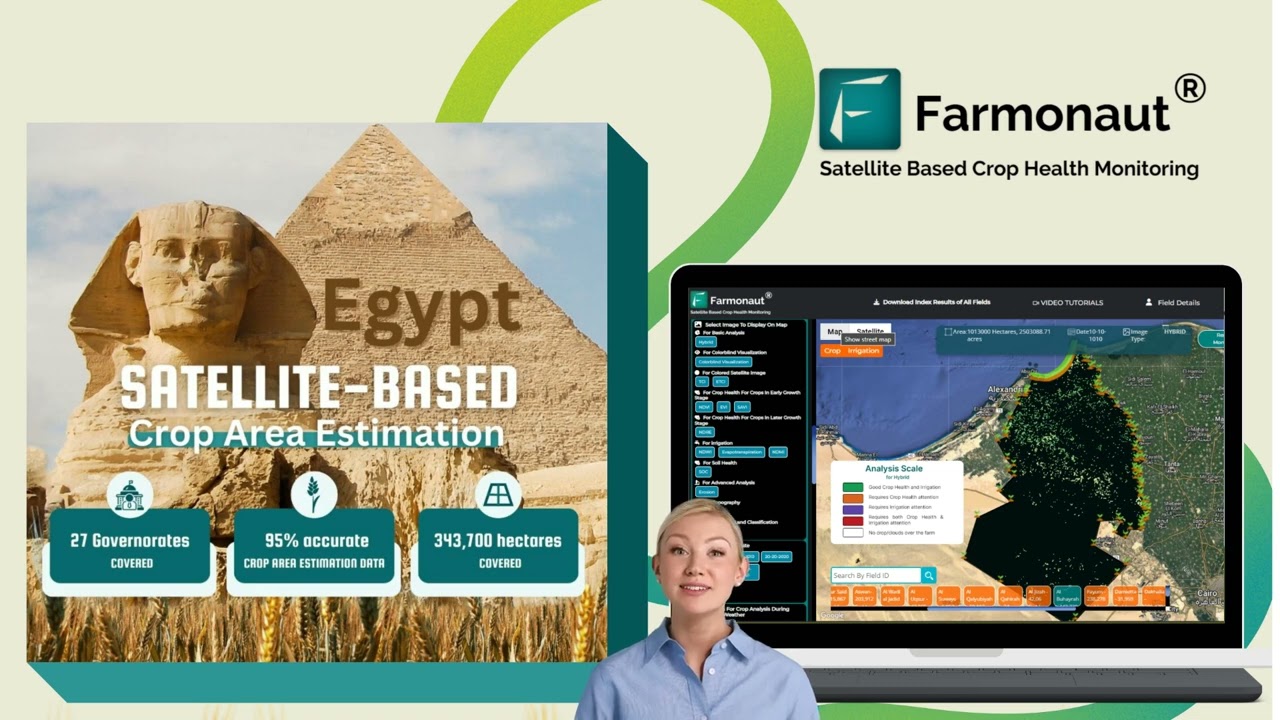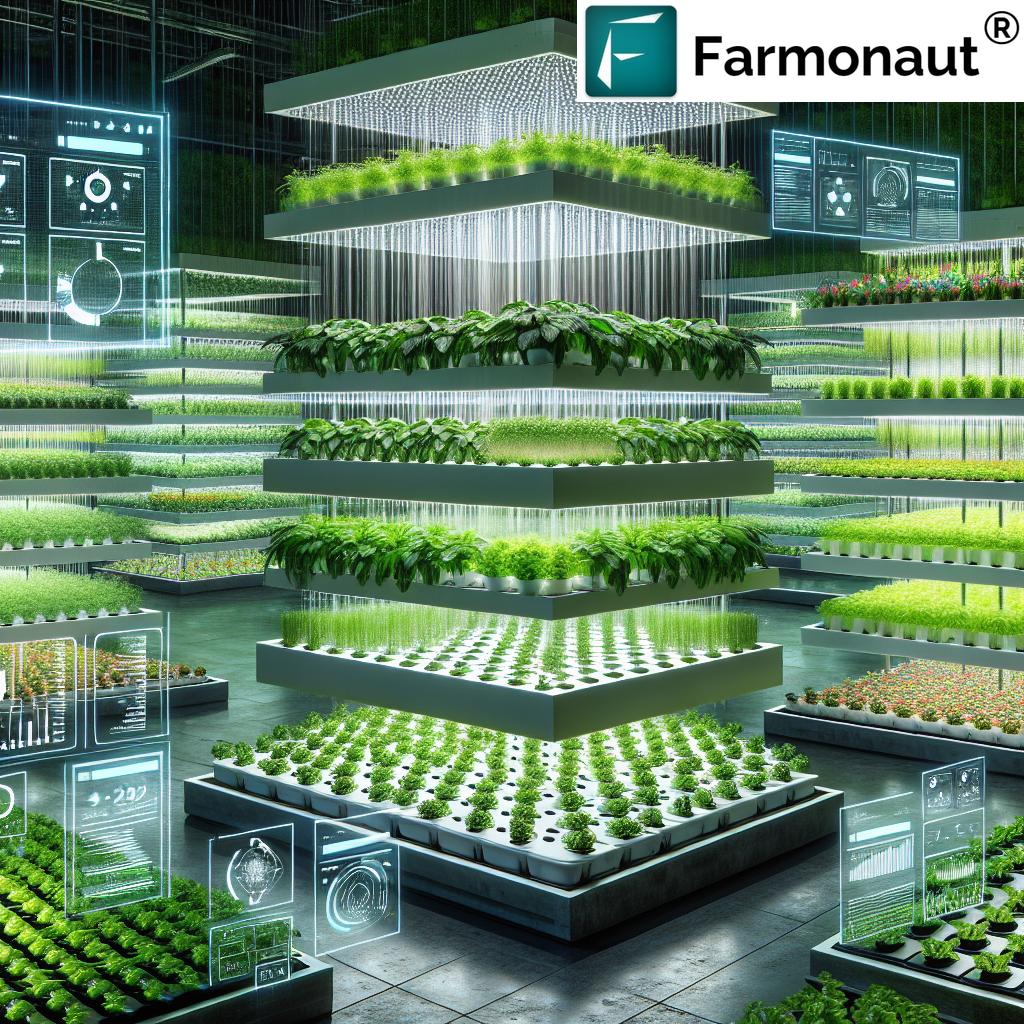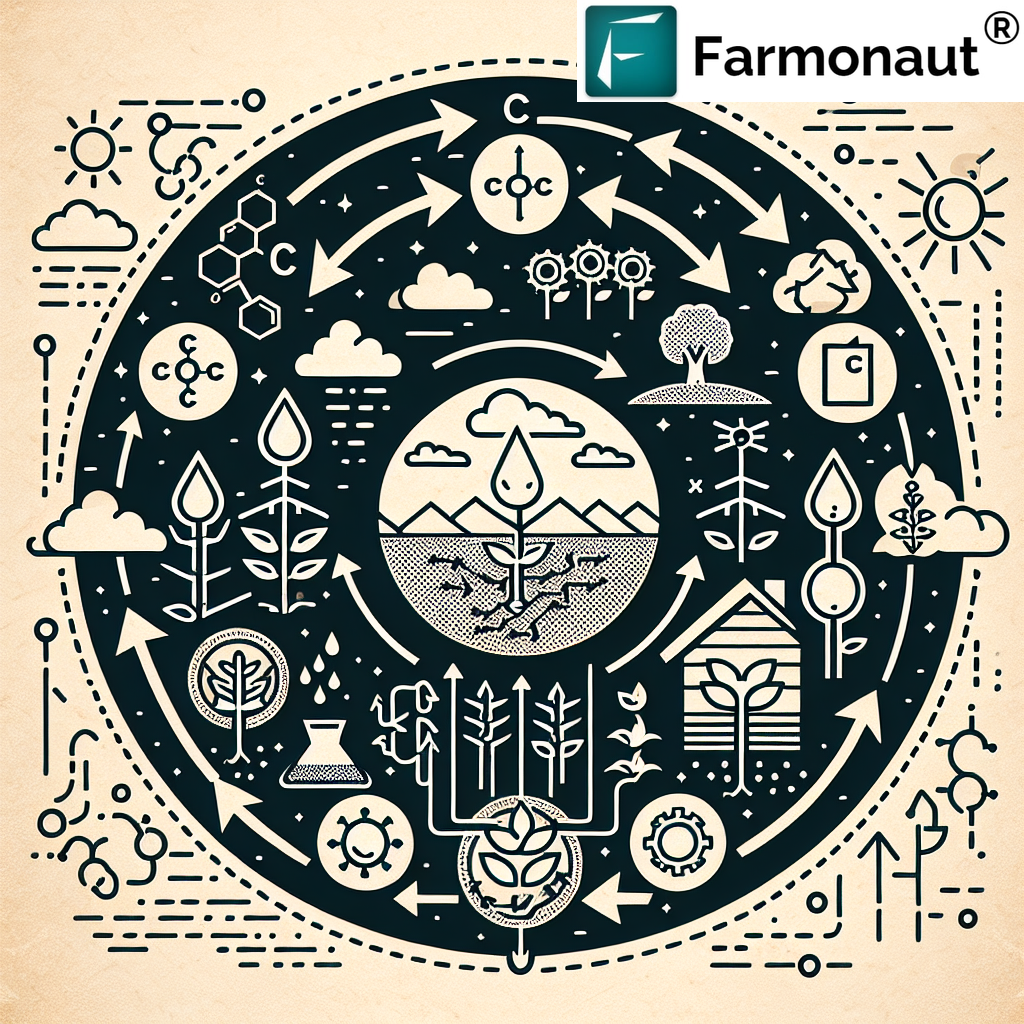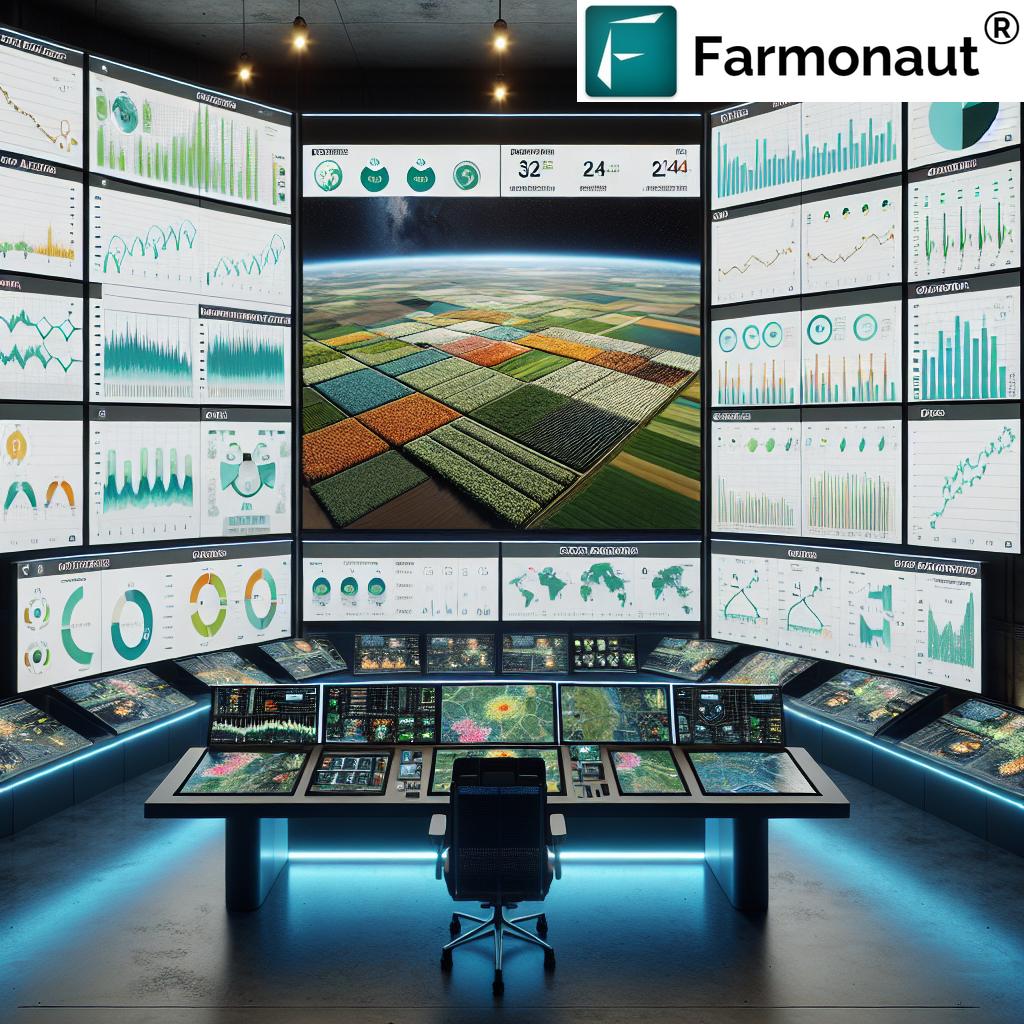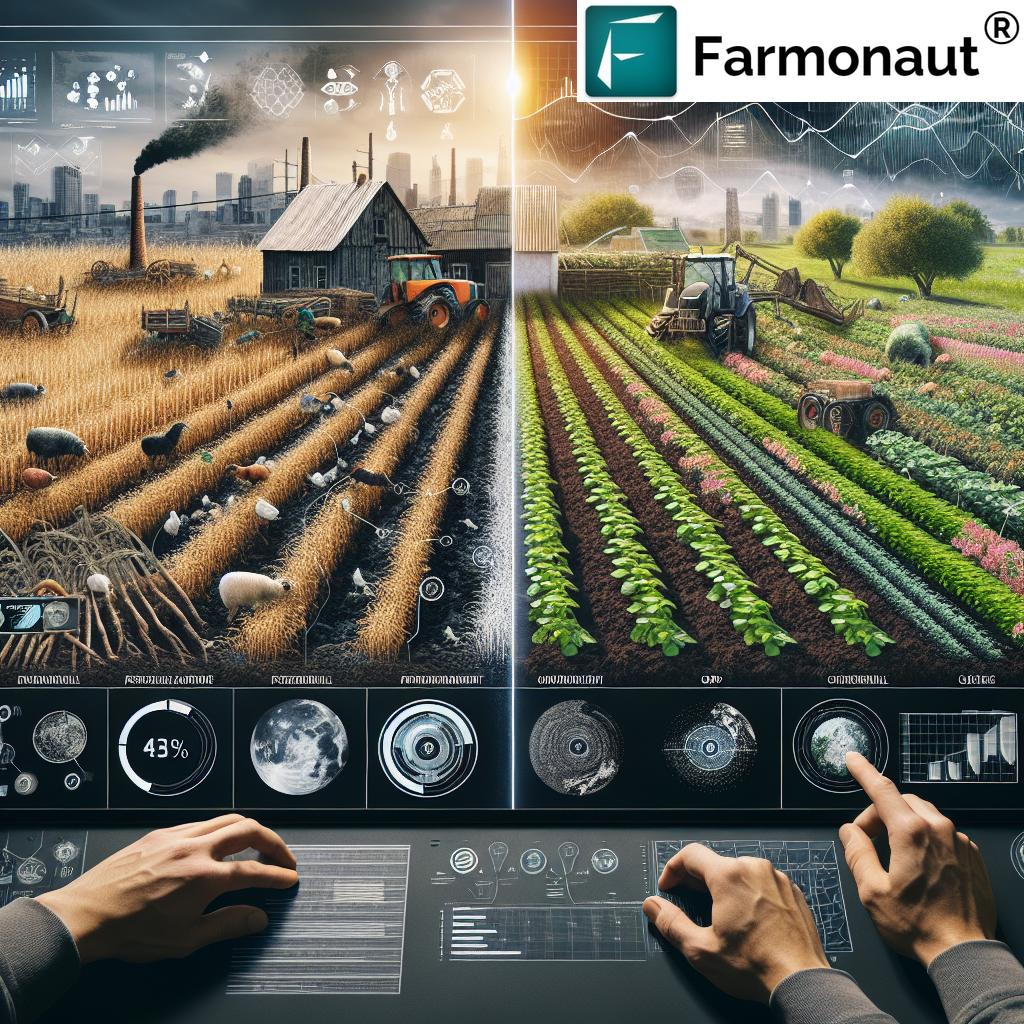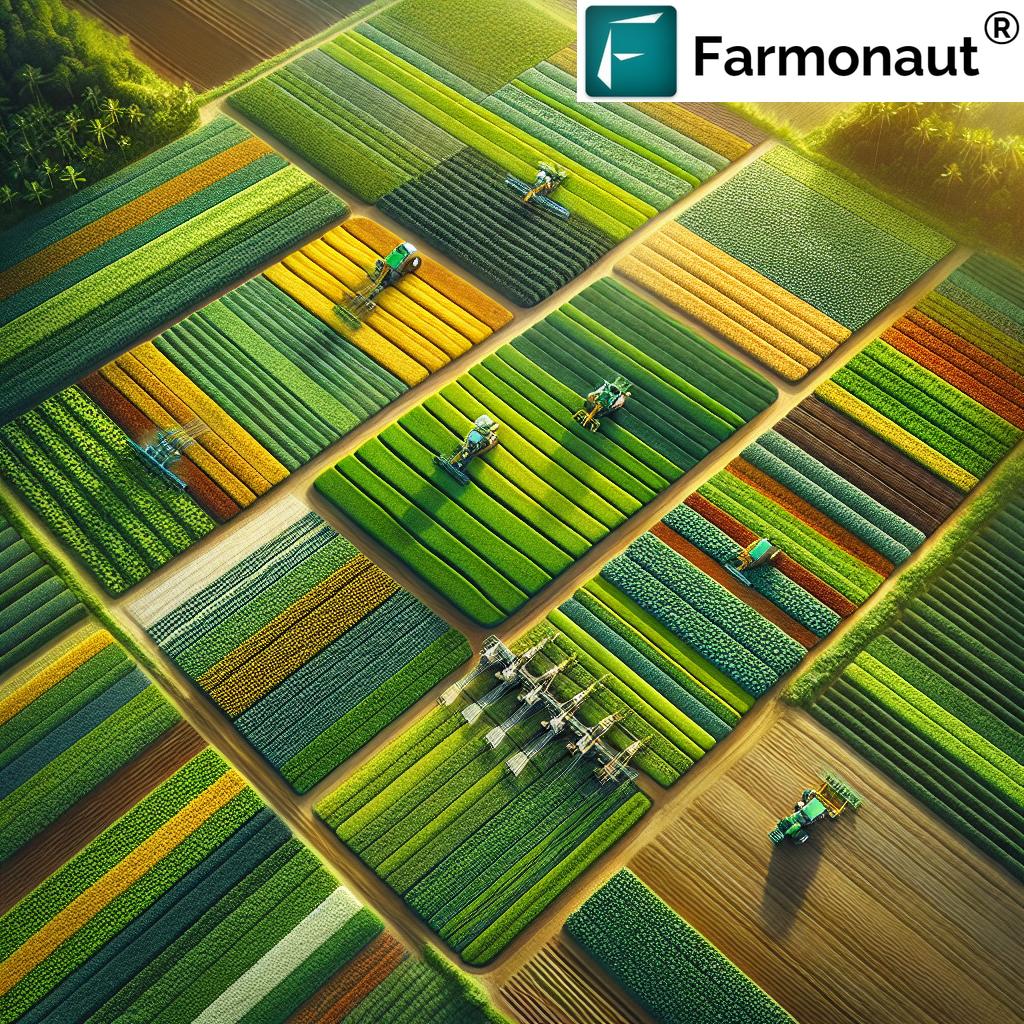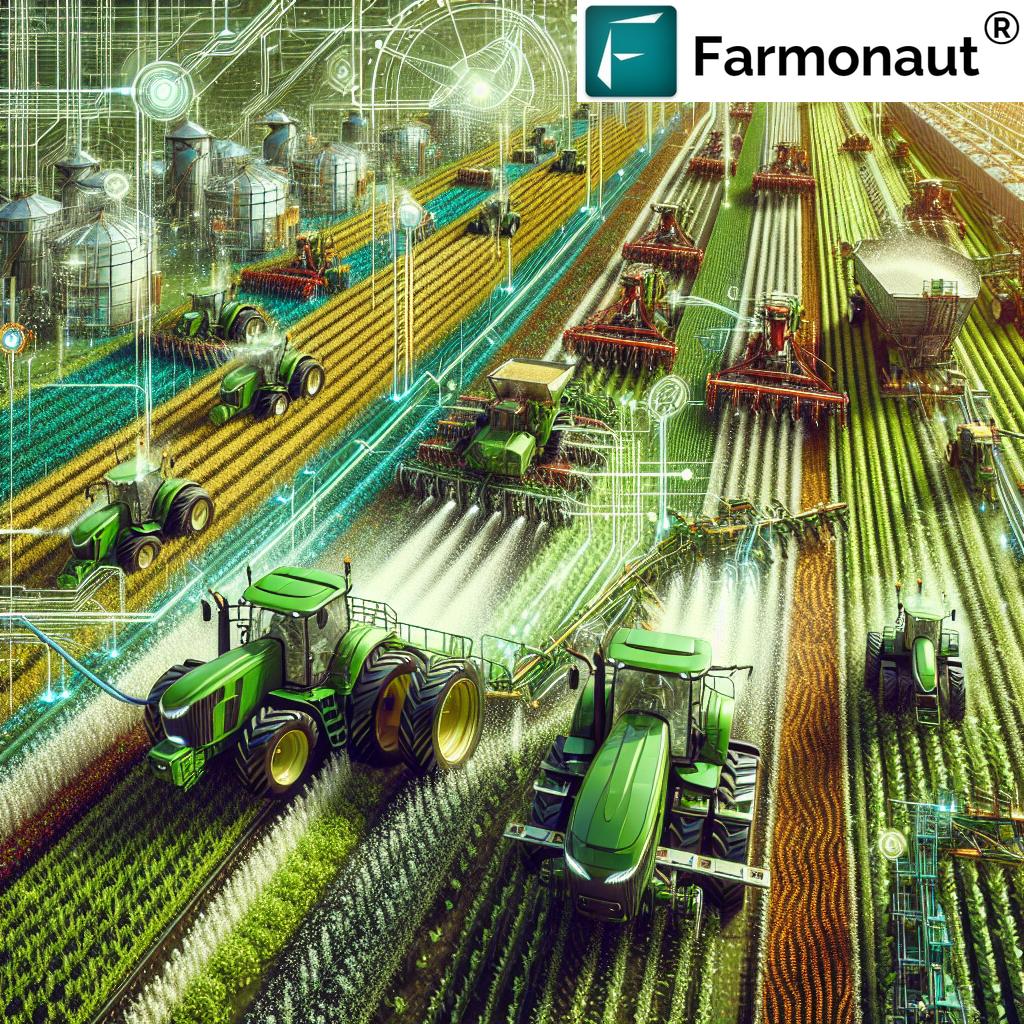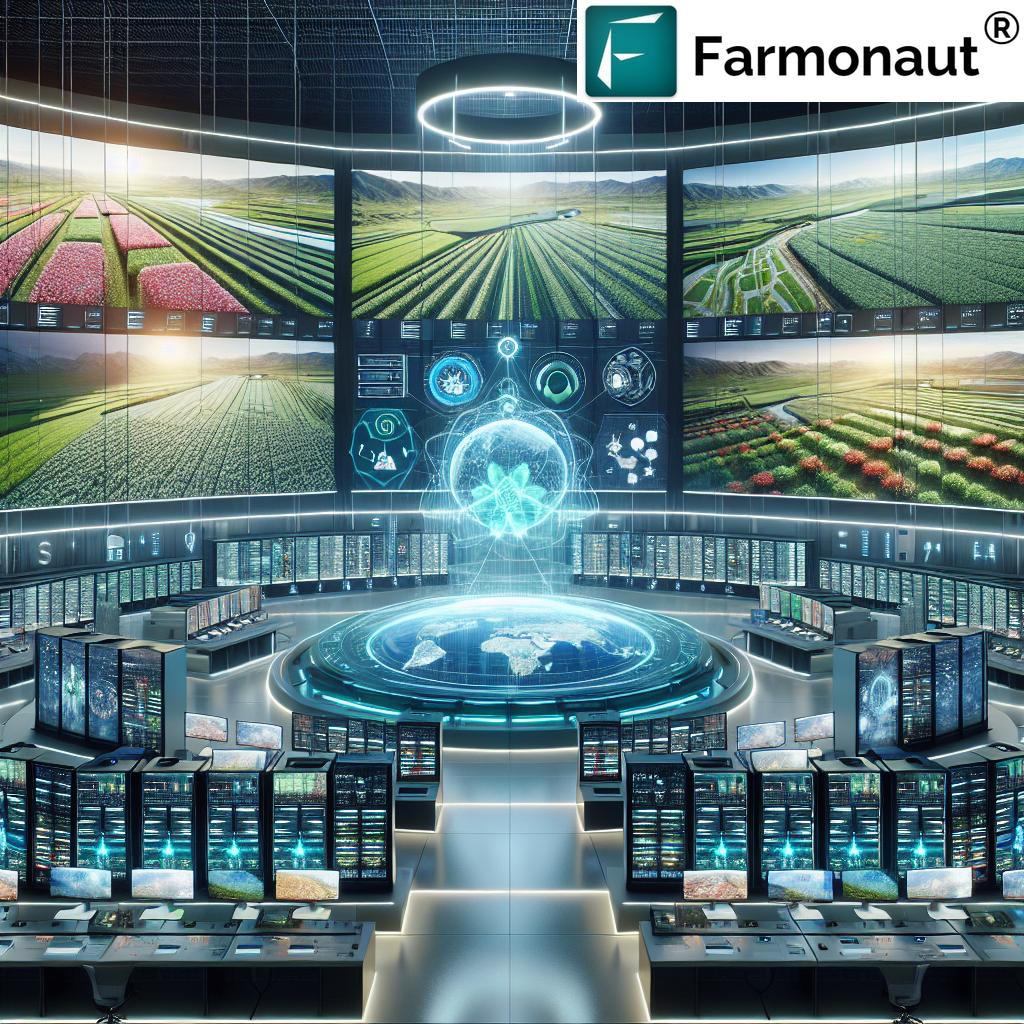Technology in Farming: 7 Surprises Transforming Agriculture
“Precision agriculture can increase crop yields by up to 20% using data-driven decisions and advanced technology.”
Table of Contents
- Introduction: The Rise of Technology in Farming
- 1. Precision Agriculture: Data-Driven Decisions
- 2. Farm Automation Systems: Robotics Redefining Labor
- 3. AI in Agriculture: Smart Analytics & Predictive Power
- 4. Controlled-Environment Agriculture (CEA): Future-Ready Farming
- 5. Smart Irrigation Solutions: Saving Every Drop
- 6. Nano Sensors and Emerging Technologies
- 7. Blockchain, Traceability, and Sustainable Management
- Comparison Table: Agricultural Technologies & Their Impacts
- Adoption Challenges and Considerations
- Farmonaut: Pioneering Affordable Precision Agriculture
- FAQ: Technology & Innovation in Agriculture
- Conclusion
Introduction: The Rise of Technology in Farming
In recent years, the agriculture landscape has witnessed an unprecedented transformation driven by the integration of technology and advanced systems. This revolution—aptly termed AgTech—has supercharged farming practices worldwide, fundamentally enhancing efficiency, sustainability, and productivity. From precision agriculture and farm automation systems to AI-driven analytics and resource monitoring, innovative technologies are redefining how we manage soil, water, labor, and crops.
But what are the most surprising advancements—and how do they shape agriculture’s future?
Join us as we explore seven game-changing surprises in technology and farming. We’ll highlight how precision, automation, and AI are empowering farmers to maximize yields, minimize waste, and combat mounting challenges like climate variability, resource scarcity, and labor shortages.
1. Precision Agriculture: Data-Driven Decisions
When we think of innovation in agriculture, precision agriculture often leads the discussion. This advanced methodology uses technology to monitor and manage field variability within fields, empowering us to fine-tune our inputs and maximize returns.
What Is Precision Agriculture?
At its core, precision agriculture harnesses GPS technology, satellite imagery, crop monitoring sensors, data analytics, and smart equipment to track soil health, crop growth, and equipment performance in real time.
This data-rich approach moves us away from one-size-fits-all applications, allowing highly targeted application of fertilizers, pesticides, and water. The result? Drastic reductions in input waste, diminished environmental impact, and improved yields—all while making smarter decisions based on real field conditions.
- GPS-guided tractors and machinery for accurate planting and harvesting
- Soil sensors that monitor moisture, nutrient levels, and pH
- Satellite and drone imagery for in-depth crop health mapping
- Variable-rate application – apply resources only where they’re needed
By analyzing weather forecasts, historical patterns, and real-time field data, we can optimize schedules for planting, irrigation, and harvest with unprecedented precision. This is the heart of sustainable farming technologies.
Did you know? Platforms like Farmonaut are making precision agriculture affordable and accessible for farmers worldwide, using satellite imagery for crop monitoring, soil moisture tracking, and data-driven advisory.
Key Benefits of Precision Agriculture
- Boosts crop yields by up to 20% by addressing field variability.
- Reduces water, fertilizer and pesticide usage by precise targeting, saving costs and protecting the environment.
- Provides real-time insights to quickly detect diseases and address pest outbreaks.
- Supports effective resource management and sustainability goals.
Farmonaut offers both smallholders and large-scale operations premium carbon footprinting tools as a part of modern farm management—tracking real-time emissions and helping us reach sustainability targets. Incorporating large scale farm management solutions, we gain customizable insights based on hectares monitored and frequency of satellite data.
“Automation in farming has reduced labor costs by nearly 30% in technologically advanced agricultural regions.”
2. Farm Automation Systems: Robotics Redefining Labor
One of the striking surprises in agricultural transformation is the remarkable progress of farm automation systems. As labor shortages intensify and the quest for efficiency continues, robotic harvesting equipment, autonomous tractors, and automation in seeding, weeding, and irrigation are becoming mainstream.
How Automation Is Changing the Face of Farming
- Robotic harvesters can pick fruits and vegetables at optimal ripeness, minimizing food waste.
- Smart weeders use cameras and machine vision to identify weeds and remove them mechanically or with targeted pesticide application.
- Automated seeders and planters deliver uniform planting, boosting yields and crop uniformity.
- Smart irrigation solutions use soil moisture sensors and weather analytics to apply the precise amount of water needed—no more, no less.
Automation doesn’t just mean robots—it means combining real-time analytics with physical action. For example, Farmonaut’s web and mobile apps give agribusinesses automated fleet and resource management capabilities, optimizing the use of equipment and reducing operational costs.
Benefits of Farm Automation Systems
- Addresses labor shortages and reduces dependency on seasonal labor.
- Increases accuracy and repeatability in tasks such as planting, weeding, and harvesting.
- Minimizes crop losses with timely, optimal harvesting.
- Lowers manual labor costs by up to 30% in technology-driven regions.
Farm automation is especially valuable in large-scale plantations. If we want to enhance fleet safety, track equipment usage, and boost machinery lifespan, Fleet Management solutions from Farmonaut can play a pivotal role.
3. AI in Agriculture: Smart Analytics & Predictive Power
Artificial intelligence is at the core of the next-generation analytics that are reshaping how we monitor crops, predict yields, and optimize resource allocation. AI in agriculture is about leveraging machine learning models to process huge amounts of agricultural data—from satellite imagery and weather forecasts to soil conditions and historical yields.
Examples of AI Transforming Farm Management
- Predicting crop yields: AI algorithms synthesize variables like weather, soil health, and historical patterns, enabling better financial planning and supply chain coordination.
- Disease and pest detection: AI-powered systems use satellite or drone imagery to identify symptoms, recommend targeted treatments, and help prevent major outbreaks.
- Smart decision support: AI-based advisory systems like Jeevn AI analyze real-time data for custom irrigation or input schedules, instantly boosting productivity and sustainability.
Farmonaut’s platform exemplifies the power of AI-driven agricultural data analytics, providing actionable insights for resource management and risk mitigation.
Benefits of AI in Sustainable Farming
- Rapid detection of stress, nutrient deficiencies, or diseases in crops.
- Automated alerts for weather risks, irrigation timing, or harvest readiness based on predictive analytics.
- Optimization of resource allocation to lower input costs and reduce environmental impact.
If you want to further optimize your agricultural business, exploring Farmonaut’s API and their comprehensive API Developer Docs is highly recommended for seamless integration with your digital systems.
4. Controlled-Environment Agriculture (CEA): Future-Ready Farming
Controlled-environment agriculture (CEA) is rewriting what it means to be a modern farmer. This innovative approach encompasses vertical farming techniques, hydroponics, and other high-tech growing environments where variables like temperature, humidity, and light are tightly regulated.
CEA liberates us from the unpredictability of weather and pests, enabling year-round production of high-value crops even in urban or resource-constrained settings.
Why Controlled-Environment Agriculture Matters
- Reduces the footprint of food production by maximizing per-square-meter efficiency.
- Slashes transport costs and carbon emissions by shrinking the distance from farm to fork.
- Conserves water and fertilizer via recirculating systems.
- Provides consistent quality regardless of seasonal changes or climate risks.
CEA is crucial for regions experiencing land and resource scarcity, offering a pathway to sustainability and food security. Integrating crop plantation and forest advisory via digital platforms empowers agriculturalists to optimize varietal selection and management for these controlled systems.
5. Smart Irrigation Solutions: Saving Every Drop
Water scarcity is one of the most urgent challenges for agriculture globally. Enter smart irrigation solutions, which use advanced sensors, data analytics, and automation to ensure every drop counts.
- Soil moisture sensors monitor exactly how much water is needed.
- Weather analytics adjust irrigation schedules in sync with forecasts and in-field conditions.
- Automated valves deliver water directly to the roots, boosting crop quality and conserving resources.
Using systems that analyze satellite imagery (such as Farmonaut’s NDVI-based crop monitoring) further enhances smart irrigation, permitting us to identify stressed areas and prevent over- or under-watering.
If your agribusiness aims to document environmental impact or save costs through water optimization, carbon footprinting management tools are invaluable for tracking reductions in water and energy use.
6. Nano Sensors and Emerging Technologies
The role of nanotechnology in agriculture is expanding rapidly through the development of nano sensors and smart materials that can monitor soil health, detect pathogens, and track nutrient levels in real time.
- Graphene-based sensors capable of monitoring nitrate or phosphate concentrations for tight nutrient management.
- Ultra-sensitive soil sensors that alert us to the presence of contaminants or deficiencies.
- Pathogen detection systems that help prevent crop diseases before they spread.
- Drones and IoT devices feeding into central analytics platforms for real-time surveillance.
As emerging technologies develop further, they promise not only more data but higher delivery precision for fertilizers, pesticides, and other inputs. By integrating with platforms like Farmonaut, we can merge nano sensor outputs with satellite imagery for holistic, actionable insights.
7. Blockchain, Traceability, and Sustainable Management
Consumers are increasingly demanding transparency in how their food is sourced, and using blockchain technology in agriculture delivers exactly that. Blockchain ensures that every step—from planting to harvest to the end consumer—is recorded, verified, and tamper-proof.
- Product traceability platforms authenticate food origin, enhancing trust and reducing fraud.
- Farmers and agribusinesses can prove sustainable practices to retailers and exporters, opening new markets and commanding a premium price.
- Supply chain documentation assists in compliance and quality assurance, crucial for modern agri-exporters or organic producers.
Blockchain-based management doesn’t just benefit buyers but helps with insurance, financing, and crop loan verification, de-risking lending and opening new access to financial capital in sectors previously considered too risky.
Comparison Table: Agricultural Technologies & Their Estimated Impacts
| Technology Name | Key Features / Innovation | Estimated Increase in Efficiency (%) | Estimated Cost Reduction (%) | Sustainability Impact |
|---|---|---|---|---|
| Precision Agriculture | GPS field mapping, satellite/crop sensors, variable rate input | 15–20% | 10–15% | Reduces fertilizer & water use by up to 20% |
| AI-driven Analytics | Yield prediction, pest/disease detection, decision support | 12–18% | 8–12% | Early intervention saves crops/reduces pesticide use by ~25% |
| Farm Automation Systems | Robotic harvesters, seeding, weeding, fleet management | 20–25% | 25–30% | Lowers labor costs and minimizes crop losses |
| Drones | Aerial monitoring, targeted spraying, 3D mapping | 10–13% | 5–7% | Reduces pesticide drift, lower environmental risk |
| IoT Sensors | Real-time monitoring of soil/water/crop conditions | 10–14% | 5–8% | Efficient resource usage, reduces water by 15–20% |
| Remote Sensing | Satellite-based farm monitoring, large-scale crop health | 12–16% | 7–11% | Promotes sustainability through data-driven actions |
| Smart Irrigation | Automated valves, soil moisture analysis, weather-adaptive | 15–19% | 10–13% | Cuts water use by 20%, limits evaporation runoff |
Adoption Challenges and Considerations
While the benefits of AgTech are compelling, adopting technology in agriculture is not without hurdles. We must confront challenges such as:
- High Initial Costs: Upfront investment for advanced sensors, automation, or analytics platforms can be significant, especially for smallholder farmers.
- Technical Complexity: Integrating new systems into existing farming practices demands technical know-how and regular support.
- Labor Transition: Automation may displace some manual jobs, requiring retraining and new roles in agri-tech management and data analysis.
- Data Security: With the rapid digitalization of farm data, ensuring robust cybersecurity and respecting farmers’ privacy rights is essential.
- Equitable Access: Bridging the digital divide requires affordable platforms and effective training for all users.
Solutions like Farmonaut directly address these barriers through cloud-based, satellite-driven tools that avoid expensive hardware, providing affordable entry points for a diverse audience of farmers, agribusinesses, and government organizations worldwide.
Farmonaut: Pioneering Affordable Precision Agriculture
Farmonaut is at the forefront of the AgTech revolution, offering advanced, satellite-based farm management accessible on Android, iOS, web-app, and via API. By democratizing precision agriculture with affordable, scalable solutions, Farmonaut empowers both smallholder and large-scale farmers to leverage:
- Real-time crop health monitoring (NDVI, soil moisture, disease detection)
- AI-based personalized advisory (Jeevn AI)
- Blockchain-powered product traceability for transparent and tamper-proof supply chains
- Fleet and resource management for agribusinesses
- Carbon footprinting with real-time emission tracking for true sustainability
- Satellite verification for crop loans and insurance to improve financing access and reduce fraud
With a subscription-based model that flexes with our needs, Farmonaut provides a modular, budget-friendly approach to technology adoption in agriculture, making digital transformation possible for every farming operation.
FAQ: Technology & Innovation in Agriculture
What is precision agriculture and why is it important?
Precision agriculture uses advanced data, GPS, sensors, and analytics to apply precise amounts of water, fertilizer, and pesticide. It results in higher yields, lower costs, and more sustainable use of natural resources.
How do farm automation systems reduce costs?
Automated machinery and robotics reduce the need for manual labor, lower human error, and speed up repetitive tasks such as planting, weeding, and harvesting, cutting labor expenses and improving efficiency.
How does AI help in agriculture?
Artificial intelligence analyzes field and weather data to predict crop yields, identify risks, guide irrigation, and trigger alerts—helping farmers make the best decisions.
What are the advantages of controlled-environment agriculture?
CEA provides stable, regulated growing conditions using vertical farms or hydroponic towers, enabling year-round, high-quality crop production with minimal water and land usage.
Can small farms afford these new technologies?
Platforms like Farmonaut specifically aim to make advanced agri-tech affordable, eliminating the need for expensive equipment and offering flexible subscription models tailored to farm size.
Conclusion
The agricultural revolution of the 21st century is powered by a fusion of technology and traditional wisdom. Precision agriculture, automation, AI, data analytics, and blockchain have opened new dimensions for sustainability, productivity, and resource efficiency in farming. These innovations offer practical solutions to enduring problems—addressing labor shortages, stewarding water and soil health, and navigating the complexity of today’s food supply systems.
By embracing platforms like Farmonaut, we propel our farms into a new era of precision, transparency, and profitability. The challenges are real, but so are the opportunities to build a future where farming is data-driven, automated, and truly sustainable for ourselves and generations to come.
Ready to transform your farm management experience?
Explore Farmonaut’s suite of tools and subscribe today for a smarter, greener, and more productive farm.







